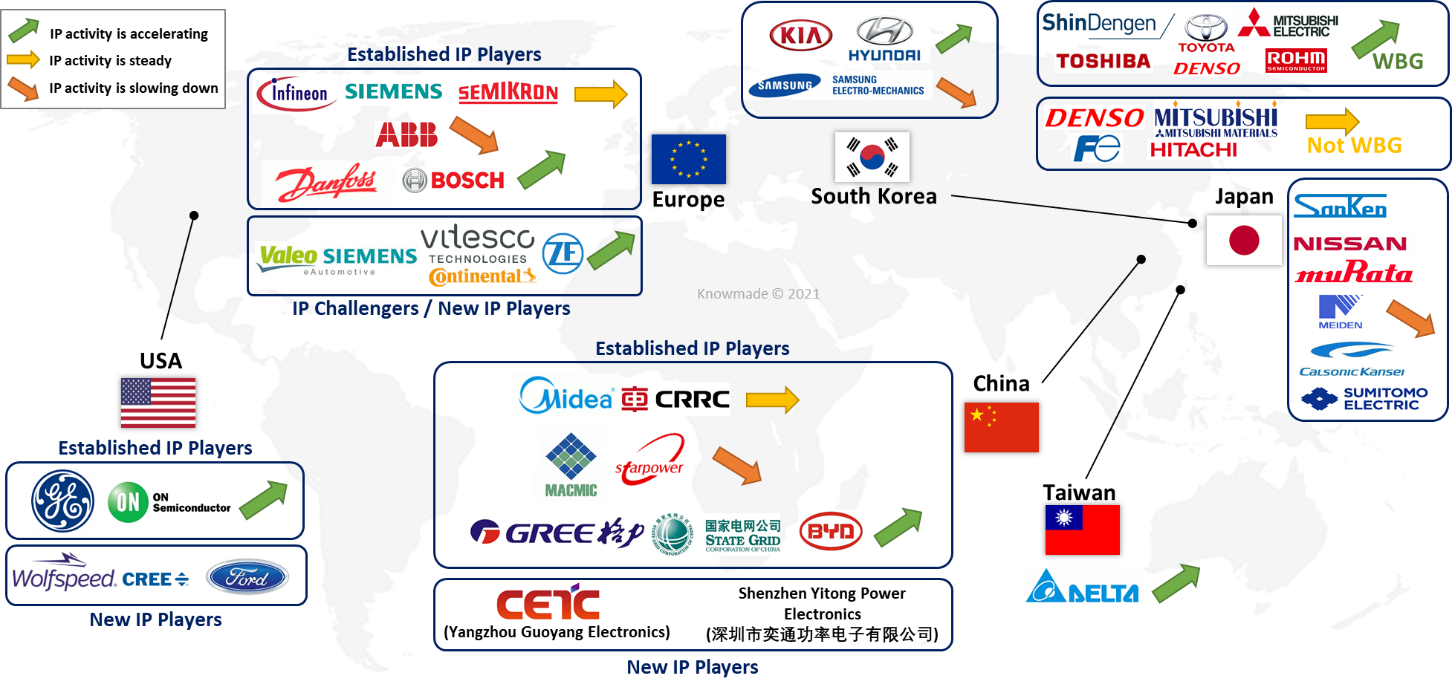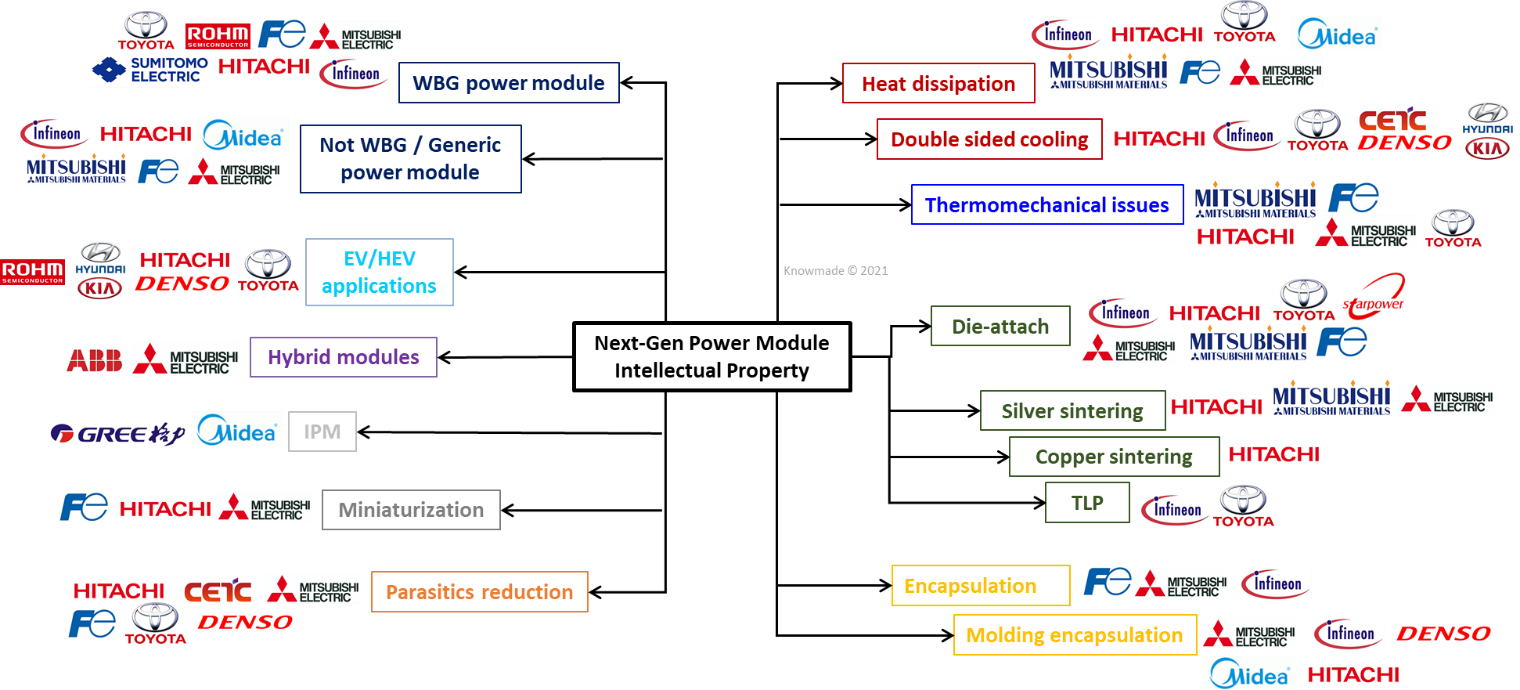SOPHIA ANTIPOLIS, France – January 28, 2021 | The last decade has seen EV/HEV applications driving packaging innovation in power electronics and creating new equations to solve for module makers, in particular further downsizing, higher power density, higher reliability and lower cost/higher manufacturability. On top of that, automotive OEMs are asking for highly standardized power modules, while most module makers focus on proprietary module designs through which they can offer more differentiating added value. In this context, automotive OEMs and Tiers-1 are expected to become more and more intrusive in the power module area.
Furthermore, EV/HEV applications are also pushing the adoption of new wide-bandgap (WBG) semiconductor technologies, especially SiC-MOSFETs whose commercial availability has continuously increased. However, to fully benefit from power SiC technology, it is crucial to enable high-temperature operation in SiC modules (200-300°C), e.g. through new packaging materials, as well as high-speed operation, by minimizing parasitic inductance.
As a result, the last decade was marked by extensive innovation in power module design and packaging, leading to a very high volume of patent publications.
In this context, Knowmade is releasing a new Next-Generation Power Modules patent landscape report on January 28, 2021, covering the wide-bandgap (WBG) power modules and generic/IGBT power modules addressing critical challenges for the next generation of power modules (heat dissipation, thermomechanical issues, management of parasitic signals, module miniaturization, etc.) and more specifically challenges arising from EV/HEV high requirements.
Knowmade’s analysts have selected and analyzed more than 7,000 inventions filed by more than 300 different organizations. This report gives a complete analysis of the next-generation power module competition and technology developments from patent perspective, with a focus on EV/HEV modules and SiC power modules, which are driving the innovation at design and packaging levels.
– What are the IP dynamics and key trends for patents filings, companies, countries and technologies?
– Who are the IP leaders, most active players and newcomers?
– Who are the new players or companies that are currently under the radar?
– What strategic and technological paths are leading companies and newcomers following for next-generation power modules?
– What are the very latest packaging technologies and materials for power modules disclosed in the patents?

Figure 1: Main patent assignees and their IP dynamics in the next-generation power module patent landscape.
“The IP competition is becoming more global and module makers have been progressively joined by competitors from the EV/HEV supply chain”, affirms Rémi Comyn, PhD, Technology and Patent Analyst Compound Semiconductors and Electronics at Knowmade. Top module makers in Europe (Infineon, Semikron) and Japan (Mitsubishi Electric, Fuji Electric, Hitachi) have been very active to keep their leadership in the power module patent landscape since 2010. “Interestingly, major foreign module makers are increasingly competing with their counterparts in Europe, by filing more and more European patent applications”, adds Rémi Comyn. Certain automotive OEMs (Toyota Motor, Hyundai Motor) and Tiers-1 (Denso, Bosch) are now well-established patent assignees. In addition, several notable players from the EV/HEV supply chain have joined the IP competition: semiconductor manufacturers (Cree/Wolfspeed), OEMs (Ford, BYD), and Tiers-1 (Valeo, Continental, ZF).
For EV/HEV applications, the difficult challenges have led to several IP collaborations between module makers/automotive Tiers-1 and automotive OEMs (Hyundai Motor/Infineon, ABB/Audi, Toyota Motor/Denso, Valeo/Siemens, etc. In China, major modules makers (CRRC, Macmic, Starpower) have demonstrated moderate patenting activity as of 2020, while new IP players have stepped up (CETC).
The WBG power module patent landscape is dominated by leading SiC MOSFET IP players. “Numerous IP players in the power module patent landscape have built up a significant portfolio of patents related to SiC MOSFET technologies, especially trench MOSFET technology (Rohm, Infineon, Fuji Electric, Toyota Motor, etc.) targeting automotive applications. Accordingly, they now develop their own technology for full-SiC power modules”, notes Rémi Comyn. “Most of them already had a foot in power module technology, except Cree / Wolfspeed, which started from APEI’s acquisition filing patents specifically for SiC power modules.”, adds Rémi Comyn.
Knowmade’s anaysts expects the number of patents for SiC power modules to continue growing in the next five years, as development is still on-going for many module makers (at die and module levels). According to the present segmentation, IP players such as Hitachi, Mitsubishi Electric and Toyota Motor are also developing key technologies (reduction of stray inductance, silver and copper sintering, TLP for die-attach) to address WBG-related challenges. Lately, Knowmade has identified several newcomers to the WBG power module patent landscape, including Audi, On Semiconductor, Danfoss & Shindengen Electric Manufacturing.

Figure 2: IP activity of the top patent applicants in the next-generation power module patent landscape.
In this Next-Generation Power Modules IP report, the patent corpus is segmented in four main challenges which are common to IGBT modules and SiC modules: parasitics, heat dissipation, thermomechanical issues, thermal reliability and miniaturization. “Overcoming these challenges will be even more critical for SiC power modules to become mainstream, since the added value of the technology depends on their capability to operate at higher switching speed and higher temperature than IGBT modules”, says Rémi Comyn. The patent corpus is also segmented by key technologies that are developed for next-generation power modules, for instance in die-attach (copper and silver sintering, TLP bonding), in encapsulation (transfer molding), and double-sided cooling structure. Furthermore, the report includes additional segments for patents related to intelligent power modules (IPM), hybrid modules (Si IGBT/SiC diodes or MOSFETs and GaN/Si cascode) and EV/HEV applications.
A significant part of this report is dedicated to the in-depth analysis of 40 leading players’ IP portfolio. Knowmade’s IP analysts provide an overview of the portfolio (IP dynamics, enforceability, protected countries, technology, technical challenges, applications, etc.), highlight the noteworthy patents relating new products and technology developments related to WBG, EV/HEV and related challenges, and review the very latest patented inventions.
Knowmade is releasing this new Next-Generation Power Modules patent landscape report to offer a complementary understanding of the power module competitive landscape, its evolution through, and the strategic and technological paths the leading companies and newcomers are following for next-generation power modules. All year long, Knowmade’s team has been investigating both WBG semiconductors and power electronics related patenting activities to get a deep understanding of the technology and intellectual property evolution, and their potential business impact. This Next-Generation Power Modules report is part of a collection of IP reports and IP monitors including Power SiC Patent Landscape 2019, Power GaN Patent Landscape 2019, and GaN Power & RF Patent Monitor 2021.
Explore more patent reports about Power electronics with KnowMade.
Press contact
contact@knowmade.fr
Le Drakkar, 2405 route des Dolines, 06560 Valbonne Sophia Antipolis, France
www.knowmade.com
About the author
Rémi Comyn, PhD. Rémi works for Knowmade in the field of Compound Semiconductors and Electronics. He holds a PhD in Physics from the University of Nice Sophia-Antipolis (France) in partnership with CRHEA-CNRS (Sophia-Antipolis, France) and the University of Sherbrooke (Québec, Canada). Rémi previously worked in compound semiconductors research laboratory as Research Engineer.
About Knowmade
Knowmade is a Technology Intelligence and IP Strategy consulting company specialized in analysis of patents and scientific information. The company helps innovative companies and R&D organizations to understand their competitive landscape, follow technology trends, and find out opportunities and threats in terms of technology and patents.
Knowmade’s analysts combine their strong technology expertise and in-depth knowledge of patents with powerful analytics tools and methodologies to turn patents and scientific information into business-oriented report for decision makers working in R&D, Innovation Strategy, Intellectual Property, and Marketing. Our experts provide prior art search, patent landscape analysis, scientific literature analysis, patent valuation, IP due diligence and freedom-to-operate analysis. In parallel the company proposes litigation/licensing support, technology scouting and IP/technology watch service.
Knowmade has a solid expertise in Compound Semiconductors, Power Electronics, Batteries, RF Technologies & Wireless Communications, Solid-State Lighting & Display, Photonics, Memories, MEMS & Solid-State Sensors/Actuators, Semiconductor Manufacturing, Packaging & Assembly, Medical Devices, Medical Imaging, Microfluidics, Biotechnology, Pharmaceutics, and Agri-Food.
